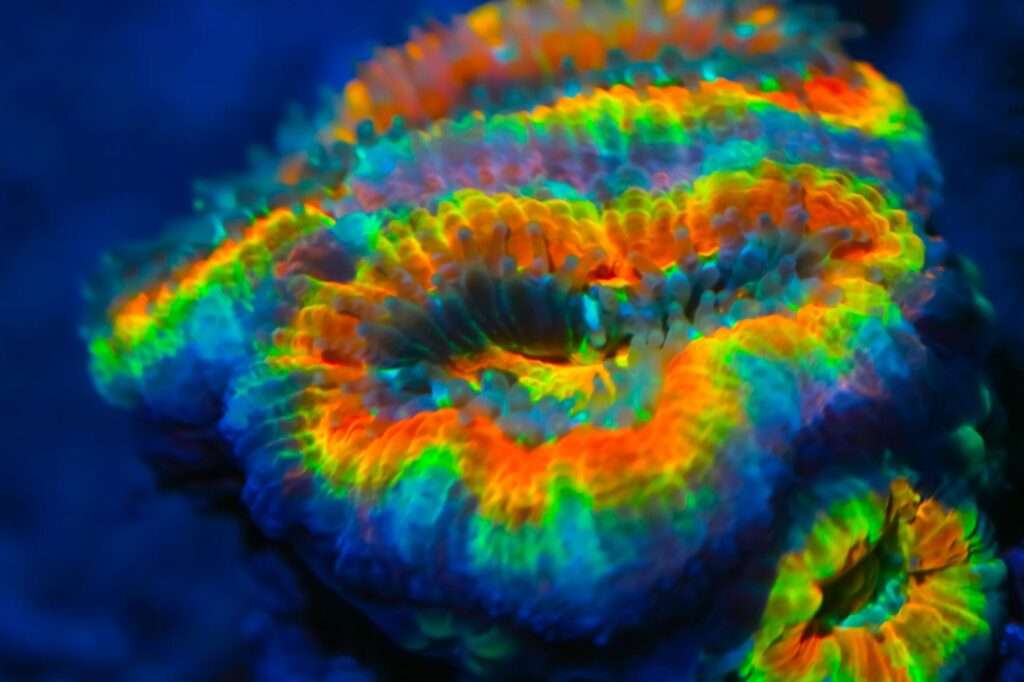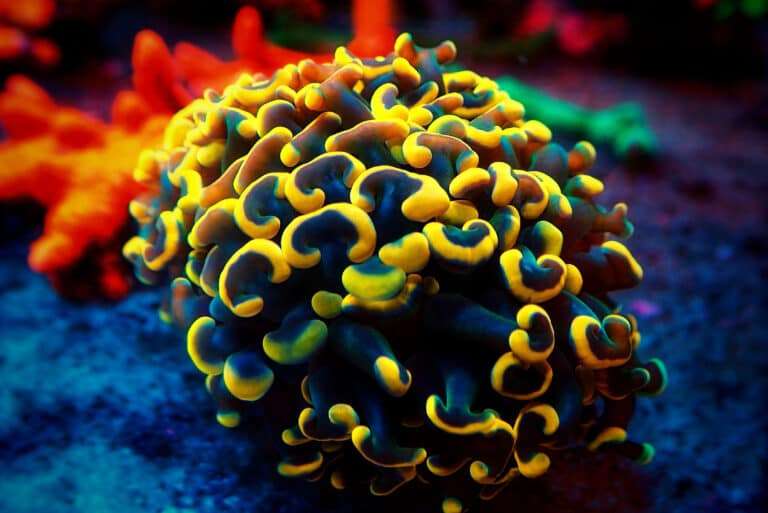
Branched Flowerpot in terms of appearance and structure, the genus Coral Alveopora sp. is unique. Their skeletal structures are large, rounded or branching in the wild, yet they are also light and permeable. They have sizable corallites that have grown into a web of rods and spines that interlock. However, their huge, elongated polyps, which can reach a maximum length of 12 inches (30 cm), are what make them stand out the most.
Branching Flowerpot Coral polyps have the ability to spread out in a spray. They feature a fringe of tentacles around their mouths (called oral discs), which frequently have knobby, bulbous tips. The tips of the tentacles or oral discs might be white or green. The tentacles may contrast with the oral discs in color, giving the organism a “daisy” look. They resemble a group of flowers in appearance. Derivative names for the coral include Daisy, Flowerpot, Sunflower, and Ball.
Habitat
De Blainville first formally introduced Alveopora in 1830. There are at least 16 actual species among the notional 27 species, 8 of which are indigenous to Australia. The Alveopora genus inhabits the Indian Ocean as well as the majority of the tropical waters of the Pacific Ocean, including the Red Sea and Australia’s East, West, and North Coasts. The Alveopora genus of corals can be found in a number of reef habitats with low to moderate current.
Morphology
The Alveopora species produce large, spherical or branched, light and porous skeletal structures. They can contain hints of bright pink, yellow, or blue in addition to their typical light brown, cream, or green hues. The tips of the tentacles or oral discs might be white or green. The oral discs’ striking contrast with the tentacles may give the creature a “daisy” appearance.
The polyps can grow to a maximum diameter of 12 inches (30 cm). The polyps grow throughout the day, but at night they partially retract. Additionally, compared to the Goniopora species, the tentacles are smaller and shorter. Unknown is the lifespan.
- Only soft surfaces in deep or shallow turbulent water are home to A. catalai. They can develop into stands that have a diameter of more than 33 feet (10 cm). They are normally amber or yellowish with white oral discs when extended and pale brownish-pink when retracted. Gnarled branches grow on mature colonies.
- The tentacle tips of A. allingi feature knobs and are often green, brown, or yellow with white bases. The tentacles have a blunt end and are more tubular in form and thinner overall. A central dot is surrounded by dots on the oral disc.
- The largest Australian Alveopora, A gigas, has tentacles that resemble those of A. catalai. While the body of the polyp is dark or greenish-brown, the tentacles have white tips and bases.
- The skeleton of A. spongiosa is so tiny that it may be sliced with a knife. The tentacles are all touching and quite closely spaced, giving the impression of a more solid surface. The polyps can occasionally have a white or greenish color on the tips in addition to their typical pale or dark brown appearance. The colonies have the shape of thick plates or pillows.
- A. verrilliana is a dark green-brown, gray, or chocolate brown plant that is native to Hawaii and has white centres. Instead of having a blunt terminus, the tentacles taper to a point.
In Captivity

- Feeding
Alveopora corals have evolved a number of feeding techniques. Many of its nutrients are obtained through a symbiotic interaction with a sea algae called zooxanthellae. They can also take in dissolved organic substances and planktonic creatures as well as food particles from the water column.
- Social Interactions and Compatibility
Alveopora corals can stretch their polyps to a distance equal to their main body’s diameter to fend off intruding corals, despite the fact that they are not aggressive. If there is no host anemone present, Ocellaris Clownfish, commonly known as False Percula, seem to prefer the Branching Flower Pot Coral.
Table





